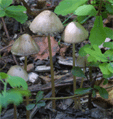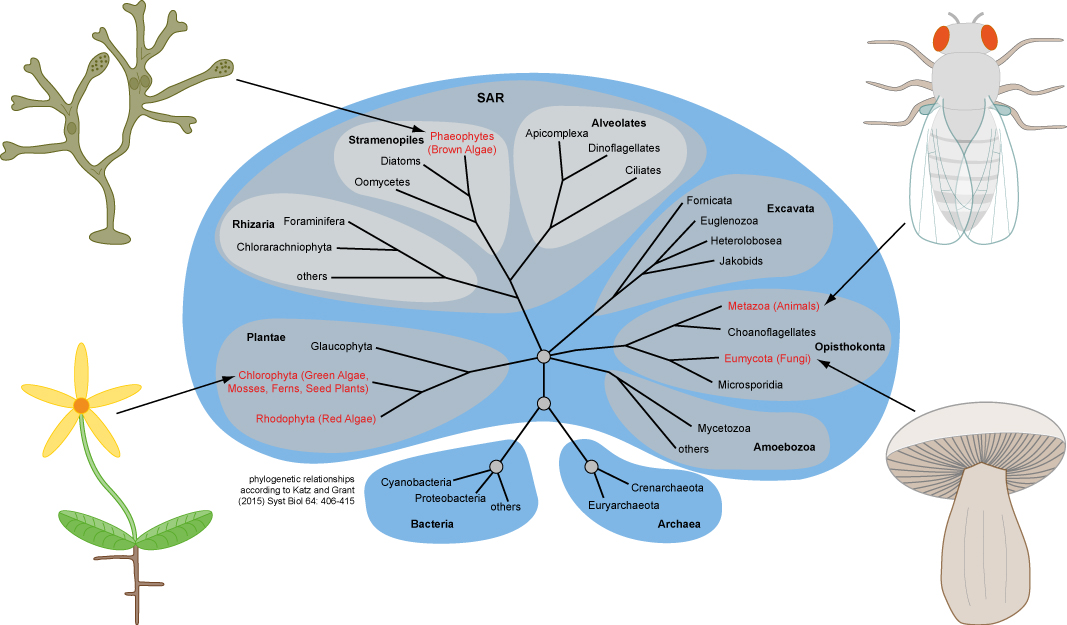
This page is thought for people who have not come across fungi much (apart, perhaps, from button mushrooms on their pizza) and who'd like to get a glimpse of where fungi occur or what they can do and why researchers are interested in them. The following list is by no means comprehensive, rather it shall arouse interest to do some further exploring of the fungal world. You can find some web pages with more information and/or pictures of fungi in the links section.
Fungi are a group of eukaryotes (organisms with nuclei in their cells) and have evolved parallel to animals. Fungi can be single cells (then they are usually called 'yeasts') or multicellular, in which case they can grow as filaments or 'hyphae' that form a 'mycelium'. Fungi occur in virtually all habitats, and the list below shows some ecologically or economically important or just interesting aspects of fungal biology.

To see how fungi are related to other organisms and among each other, click on the picture.
Fungi as food or for food production
Fungal food contaminants
- Molds, often Penicillium, Aspergillus or Rhizopus species, might be found as green or gray patches on food forgotten in the back of your frigde. Apart from not looking very appetizing, they can also produce mycotoxins that have mutagenic properties. Aflatoxin, the mycotoxin produced by Aspergillus flavus, is carcinogenic on a long term basis, and lethal when taken in higher doses.
- Some fungi colonize plant seeds and thereby cause loss of stored harvests and reduce seed germination rates.
- The ascomycete Claviceps purpurea infects rye and prevents normal grain development. Instead of a normal grain, a black, grain-like structure appears that consists of fungal hyphae which stick together and can survive the winter cold. In the spring, this 'grain' sprouts fruiting bodies in which fungal spores ripen that can infect new plants. When humans accidentally consume these 'grains', symptoms of poisoning occur which have been known for long and are described as 'St. Anthony's fire' in the older literature. Nevertheless, the toxin causing these symptoms which is called 'ergot alkaloid' is put to a more beneficial use in migraine therapy.
Fungi as drug producers
- The first fungal antibiotic to be discovered was Penicillin. It is named after a fungus that produces it, Penicillium chrysogenum. The discovery was made somewhat accidentally by Alexander Fleming in 1928 who realized that a fungus infecting his bacterial cultures inhibited bacterial growth. Since then, many fungal antibiotics have been discovered that have varying degrees of toxicity against different sorts of bacteria. One of the most potent antibiotics is Cephalosporin C which is produced by the fungus Acremonium chrysogenum.
- Antibiotics work against bacteria (not against viruses!) much more effectively than any other form of treatment known thus far. The fungi who produce them usually live in soil where they have to compete with bacteria for food resources, and getting rid of bacteria might give them an advantage in their natural habitats.
- Fungi do not only produce substances with antibiotic properties, but a vast array of so-called secondary metabolites. The chemical structures and properties of many are yet unknown, but some of them are of great medical use. Among these is Cyclosporin. It is produced by Tolypocladium inflatum and acts as a powerful immunosuppressant. Immunosuppressive drugs are important in transplantation medicine to prevent transplants from being rejected by the host's immune system.
Pathogenic fungi
Mycorrhiza, lichens and endophytes
- Many fungi do not grow alone but as symbionts. This means that they are associated with another organism as a partner, to the mutual benefit of both. Often, their association enables the symbionts to survive in habitats in which neither partner alone could grow.
- Mycorrhiza is the symbiosis of a fungus with the roots of higher plants. More than 90 % of all land plants form a mycorrhiza in their rhizosphere (their root area). Some plants are even dependent on this mycorrhiza and cannot grow without it. Mycorrhiza is beneficial for both plant and fungus, because the plant supplies the fungus with carbohydrates that are a product of plant photosynthesis (fungi cannot do photosynthesis), whereas the fungus extracts necessary nutrients like nitrogen- and phosphate-compounds from the soil and delivers them to the plant.

click on image for larger picture
- Lichens are symbionts composed of a fungus and an alga. Often, the lichen resembles neither the fungus nor the alga alone, but takes on a completely 'new look'. Lichens can grow as rather flat patches on surfaces like stone (for example in the picture below) or bushy like reindeer lichens (Cladonia spp.). They often grow in extreme habitats (extremely cold, hot, dry etc.) where neither higher plants nor any of the partners alone can persist.

click on image for larger picture
- Some fungi even grow within higher plants without being pathogenic to the plant. These fungi are called 'endophytes'. Many of them grow inside of grasses, and some of them improve plant growth. Some of them even produce mycotoxins that are toxic for grazing animals. This is benefical for the plant because it prevents the plant from being eaten, but undesirable when a meadow is used for pasture or to make hay as food for cattle.
Lignin-degrading fungi
- Lignin is a complex molecule that makes up large parts of plant secondary cell walls. It is lignin that stabilizes wood and gives it its brownish color. But because it's very complex, it's also hard to degrade, and only some fungi of the class of basidiomycetes are able to do this efficiently. Sometimes you can see their fruiting bodies on the surface of fallen trees. These mushrooms can be huge and are often shaped like one half of an umbrella.
- These basidiomycetes which are called 'white rot fungi' degrade the complex aromatic polymer lignin (colored brown) and leave behind the cellulose which is white, hence the name. This is a very important ecological function, because if it wasn't for these fungi, dead wood would accumulate pretty soon. And this would mean that plant growth would come to a halt, too, because only by degradation of biomass (not only lignin, but also other substances, many of which are degraded by fungi) and re-introduction of nutrients into the soil, new plant growth can occur. To keep up the cycle of plant growth, decay, and new growth that keeps biosystems going, fungi are absolutely necessary.
Fungi as model organisms to understand eukaryote biology
- Many fungi are easily grown in laboratories and many genetic and biochemical experiments can be performed with them much better than with animals or plants. Therefore, fungi have been used for decades as model organisms for basic research and many insights about the biology of the eukaryotic cell have been gained from experiments with fungi.
- One example is the 'one gene - one enzyme' hypothesis that was put forward by Beadle and Tatum in 1941. They investigated mutants of the fungus Neurospora crassa that were defective in exactly one gene. Beadle and Tatum found that each of these mutants was no longer able to perform one specific biochemical reaction that was catalyzed by one specific enzyme. From this, they concluded that each gene contains the information to build exactly one enzyme.
- Mitosis, the division of a single cell to give two genetically identical daughter cells, is one of the basic prinicples of how organisms grow or propagate. Information about the genetic control of this process was gained from numerous experiments with the yeast Saccharomyces cerevisiae (baker's yeast) and the filamentous fungus Aspergillus nidulans.
- Most organisms have a so-called 'circadian clock' which is something like an internal alarm clock that tells the body not only what time it is but sometimes even what to do at this time. In animals, many processes like body temperature, hormone levels, sleep-wake rhythms etc. are governed by the circadian clock and cycle with a rhythm of approximately 24 hours. Many insights into the genetic control of this clock have been gained from the analysis of the fungus Neurospora crassa (orange bread mold). In this fungus, the production of spores occurs every 22 hours and is under the control of the circadian clock.
- As we know today, most eukaryotes are unicellular organisms, but several groups have evolved the ability to form complex multicellular structures, i.e. their bodies are made up of a large number of individual cells. Among the groups that comprise multicellular species are animals, fungi, plants, and some algae (e.g. kelps), shown in red in the phylogenetic tree below. Evolution of multicellularity occured independently in these groups of organisms, as the last common ancestors of the different groups were most likely still unicellular. In order to form a proper multicellular organism, cells must have different functions depending on which body part or organ they belong to. How cells acquire these abilities and form complex three-dimensional structures (e.g. legs in animals, leaves in plants, and fruiting bodies in fungi) is the topic of developmental biology. Fungi make ideal model organisms for developmental biology because they form organs like fruiting bodies in rather short time, sometimes less than a week, and can be studied genetically. For more information about this, have a look at the projects page.









